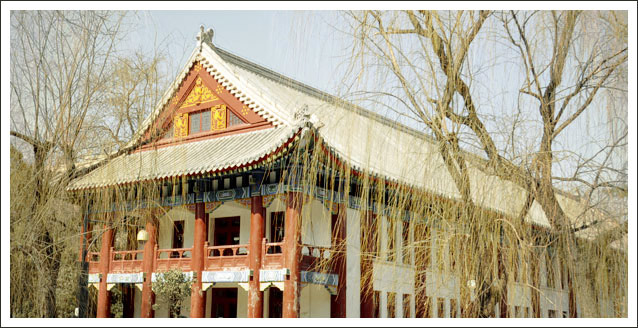文物保护
德才均备斋 Dezhai, Caizhai, Junzhai and Beizhai Buildings
时间:2017-07-26 01:37:00 来源:作者: 摄影:
德才均备斋 Dezhai, Caizhai, Junzhai and Beizhai Buildings
别名:斐斋、蔚斋、干斋、复斋或者红一楼、红二楼、红三楼、红四楼。
文物时间:1920至1929年
地理位置:四斋布置在未名湖北岸,取“水北为阳”之意。
文物类别:建筑遗迹
Alias: the First Red Building, the Second Red Building, the Third Red Building, the Fourth Red Building
Time: 1920~1929
Location: On the north bank of the WeiMing Lake
Category: Architectural relic
文物特色
四斋体量雄浑,气势开敞,与男生性格颇为相合。古香古色的雕梁、木柱、瓦当、石阶和中国传统的门窗结构,既继承了中国传统四合院的衣钵,又明显带有西方文化的痕迹。
建筑从室外到室内营造了一系列过渡空间:出挑的屋檐和台基构成第一层,基本为空,仅有上下两处限定。檐柱、额枋、雀替构成的柱廊是较通透的第二层,不过是个框架;再往里,柱子加上门窗隔扇构成第三层,分隔开了室内室外。经过这三层过渡,文物与环境融为一体。
德才均备四斋,从文物外观上看,分为两组,德斋和才斋是一组,均斋和备斋是一组。每组的两斋之间有一栋狭长的南北走向的仿明清时文物,与两斋一起并成“品”字形结构。四座宅院风格统一,整齐划一排列在未名湖的北岸,是传统的中国古代文物,处处使人感受到典雅和高贵。
文物缘起
1920年,燕京大学校长司徒雷登聘请美国著名建筑师墨菲(Henry K.Murphy)规划燕大校园。墨菲于1929年建造了燕大这所中国园林式的校园,四斋便是在那时建成的。
德斋:为纪念费先生(Mr. Finley)捐款而建;
才斋:为纪念惠先生(Mr. Wheeler)捐款而建;
均斋:为纪念甘伯尔(Mr. James N. Gamble)所捐;
备斋:为佛布思夫人(Mrs. Fannie Forbes)纪念其父所捐;
当时四斋的名称也就相应地分别为斐斋、蔚斋、干斋、复斋。 1920年,经过历史学家钱穆的建议,燕大才将四斋命名为“德才兼备”。“德才兼备体健全”不仅透露出当时的人才标准,也透露出北大教育者的眼光与期望。
岁月变迁
四斋曾经是燕京大学男生的宿舍。1952年经院系调整后,德才均备四斋已成为学校机关的办公楼。德斋,现在是北大的宣传部、组织部、发展规划部、计委等单位的办公楼;才斋,现在是北大的研究生院;均斋,现在是北大的科研部、社科部、产业部、科技开发部、国内合作部等单位的办公室;备斋现在是北大教务部和继续教育部的办公室。
寻章摘句
1930年钱穆到燕京大学任教,有一天,司徒雷登设家宴招待新来的老师,询问大家对学校有什么印象,钱直言不讳地说: 初闻燕大乃中国教会大学中最中国化者,心窃慕之,及来,乃感大不然,入校门即见”M”楼”S”楼,此何义,谓中国化者又何在。此宜予以中国名称始是。一座默然,后燕大特为此开校务会议,遂改“M”楼为“穆”楼,“S”楼为“适”楼,“贝公”楼为“办公”楼,其他建筑一律赋以中国名称。园中有一湖,景色绝佳,竞相提名,皆不适,乃名之曰未名湖。此实由余发之。有人知此事,戏谓余曰,君提此议,故得以君之名名一楼,并与胡适名分占一楼,此诚君之大荣矣。
——钱穆,《在北平燕京大学》,《燕大文史资料》,第五辑,12页。
Distinguishing feature
Alongside the northern bank of the Unnamed Lake stand four well-known buildings in line, Dezhai, Caizhai, Junzhai and Beizhai. All of the four buildings feature the traditional Chinese architecture with vaulted carved roofs and brightly painted columns, adding to the poetic beauty of the Unnamed Lake.
History
In 1920, John Leighton Stuart, the University President as well the supervisor of campus planning, invited Henry K Murphy, a renown American architect, to make detailed plans for the layout of the campus. Mr. Murphy had been working in China for years, so his design fully represented the characteristics of classical Chinese gardens. Completed around 1929, the four structures were among his masterpieces in architecture designing.
Naming Reason
“De”, “Cai”, “Jun” and “Bei” have special meanings in Chinese. De means virtue, Cai means talent, Jun stands for versatility and Bei means having or bearing. All together, the four characteristics form an Chinese idiom, indicating that the University aiming to produce versatile students with both virtue and talents. Until today, it is still the pursuit of Peking University and the standard of personal excellence in China.



